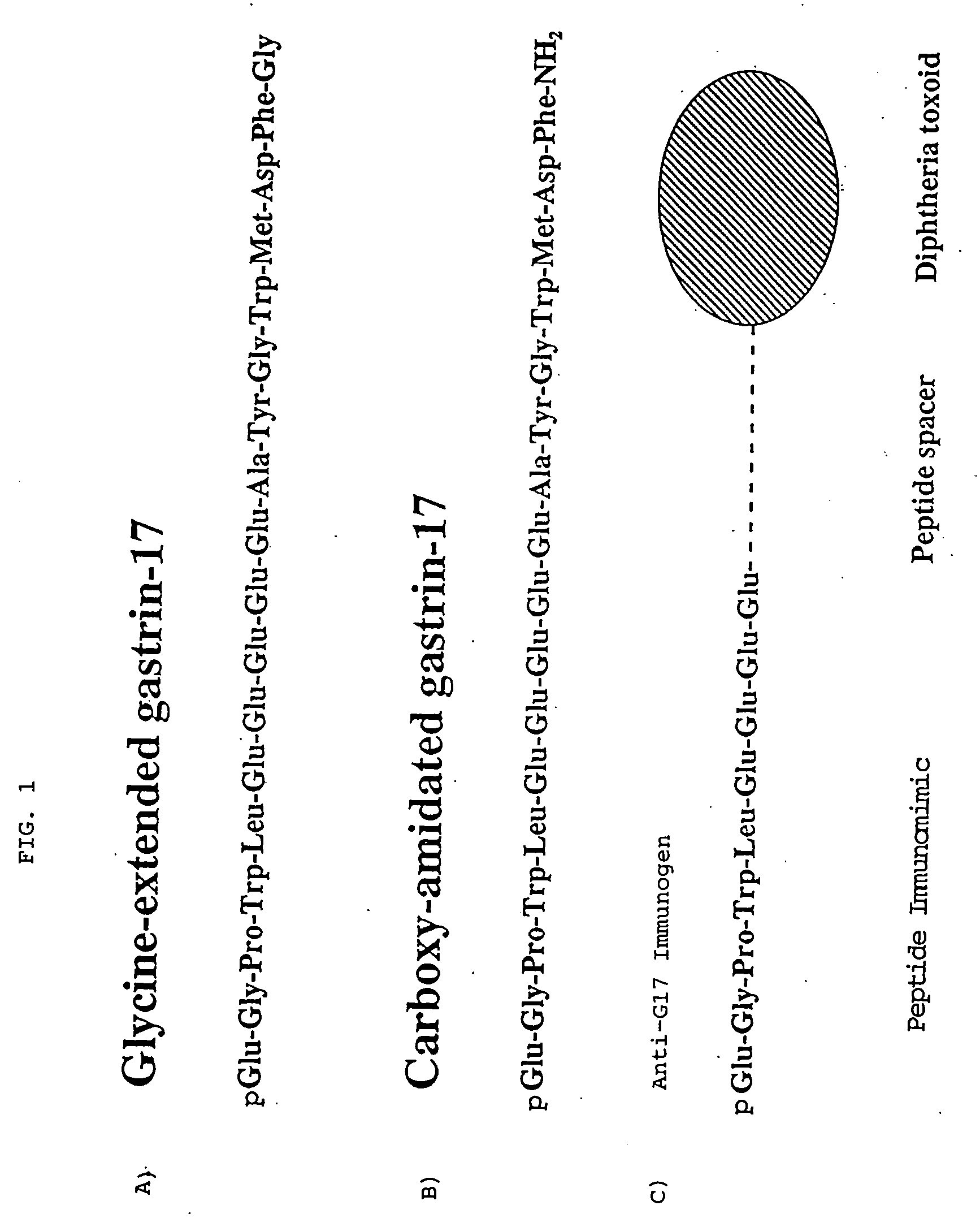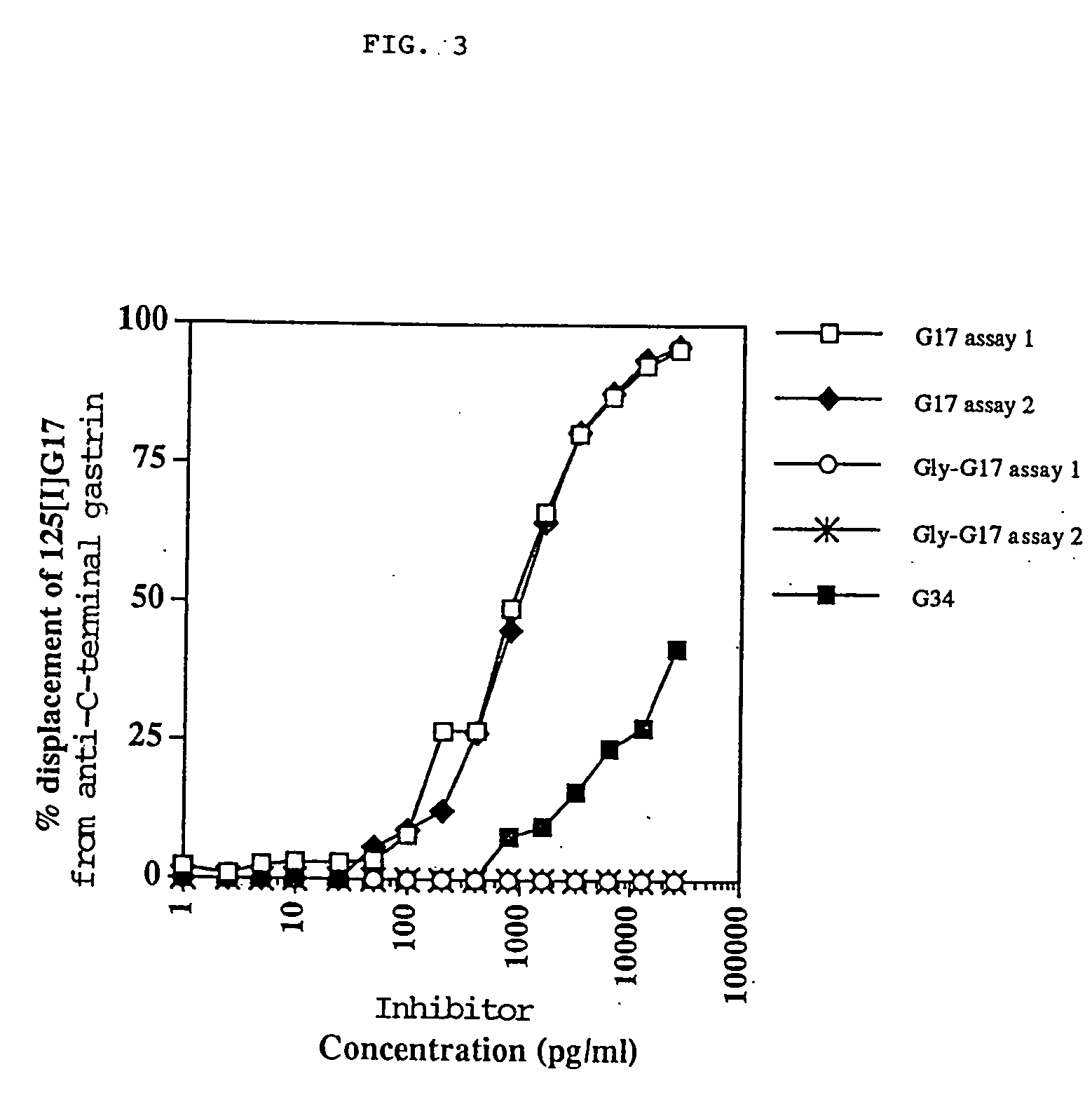Immunological methods for the treatment of gastrointestinal cancer
a technology for gastrointestinal cancer and immunoglobulin, applied in immunoglobulins against hormones, immunological disorders, antibody medical ingredients, etc., can solve the problems of tumors not being located or present in anatomic sites, cancer cells losing the ability to complete prohormone processing, and affecting the treatment
- Summary
- Abstract
- Description
- Claims
- Application Information
AI Technical Summary
Benefits of technology
Problems solved by technology
Method used
Image
Examples
example 2
[0033] These experiments show that the DHDK12 rat colonic cells produce glycine-extended gastrin 17 and that anti-G17 antiserum reduces the levels of precursor gastrin produced by the cells.
[0034] Radioimmune Assay of Precursor Gastrin Levels DHDK12 cells were grown to sub-confluence in RPMI 1640 culture medium (Gibco, Irvine, Scotland, UK) supplemented with 2 mM glutamine (Sigma, Poole, Dorset, UK) and 10% heat-inactivated foetal calf serum (FCS, Sigma). The cells were incubated in humidified conditions at 37.degree. C. with 5% CO.sub.2. Cells were harvested with 0.025% EDTA (15 minutes at 37.degree. C.), washed by centrifugation and 2.times.10.sup.6 cells seeded into flasks containing serum-free medium (RPMI 1640 in a 1:1 ratio with Hams F12 (Gibco) with 0.5% bovine serum albumen [BSA]). Cells were harvested with 0.025% EDTA, washed, re-suspended in 1 ml of sterile distilled water and heated in a boiling water bath. The levels of glycine-extended gastrin were measured by radioimmu...
example 3
[0042] The following experiments demonstrate that immunization of rats with the Rat G-17 (1-9) DT immunogen markedly inhibits the growth of DHDK12 tumors in vivo.
[0043] Experimental Animals
[0044] Male BDIX rats (The Animal Unit, University of Liverpool, UK) of age 6-10 weeks weighing 340-430g were housed in pairs and maintained in a cycle of 12 hours light and 12 hours dark at 25.degree. C. with 50% humidity. The rats were allowed to acclimatize for at least 7 days before use.
[0045] Immunization Procedure
[0046] Rat G17(1-9) coupled to DT or the DT component alone were dissolved in sterile saline (0.9%), pH 7.3 at 1 mg / ml. The adjuvant nor-muramyl dipeptide (nor-MDP, Peninsula Labs., CA) was added to the conjugate to give a final concentration of 5001 g / ml. The aqueous solution was mixed with oil (Montanide ISA 703 AMS Seppic, Inc., Paris, France) in a 1:1 ratio (vol:vol) and placed in a glass syringe which was attached to a second syringe with a three-way stopcock as connector and t...
example 4
[0052] The experiments show the levels of anti-rat G17 antibodies induced in immunized rats that were implanted with DHDK12 tumors.
[0053] Anti-rat G17 Antibody Levels of Rat G17(1-9): DT-immunized Rats
[0054] To determine the antibody response to the emulsified rat G-17(1-9)DT immunogen, rats were tail-bled at various time points and an ELISA technique was used to determine the anti-rat G17:DT antibody titers.
[0055] A rat G17-BSA conjugate was prepared at a concentration of 2 .mu.g / ml in Glycine buffer (0.1 M, pH 9.5) and 25 .mu.l was plated per well into 96-well Immunlon U plates (Dynatech Labs., Sussex, UK) and incubated overnight at 4.degree. C. The unabsorbed conjugate was then flicked out and the wells washed in buffer which consisted of 0.9% saline, pH 7.3 containing 0.5% Tween-20 (Sigma) and 0.02% NaN.sub.3 (Sigma). This buffer was used for both washing and reagent dilutions. The test sera (from animals immunized with the rat gastrin immunogen) were used at a starting dilution...
PUM
| Property | Measurement | Unit |
|---|---|---|
| concentrations | aaaaa | aaaaa |
| concentrations | aaaaa | aaaaa |
| concentrations | aaaaa | aaaaa |
Abstract
Description
Claims
Application Information
 Login to View More
Login to View More - R&D
- Intellectual Property
- Life Sciences
- Materials
- Tech Scout
- Unparalleled Data Quality
- Higher Quality Content
- 60% Fewer Hallucinations
Browse by: Latest US Patents, China's latest patents, Technical Efficacy Thesaurus, Application Domain, Technology Topic, Popular Technical Reports.
© 2025 PatSnap. All rights reserved.Legal|Privacy policy|Modern Slavery Act Transparency Statement|Sitemap|About US| Contact US: help@patsnap.com



